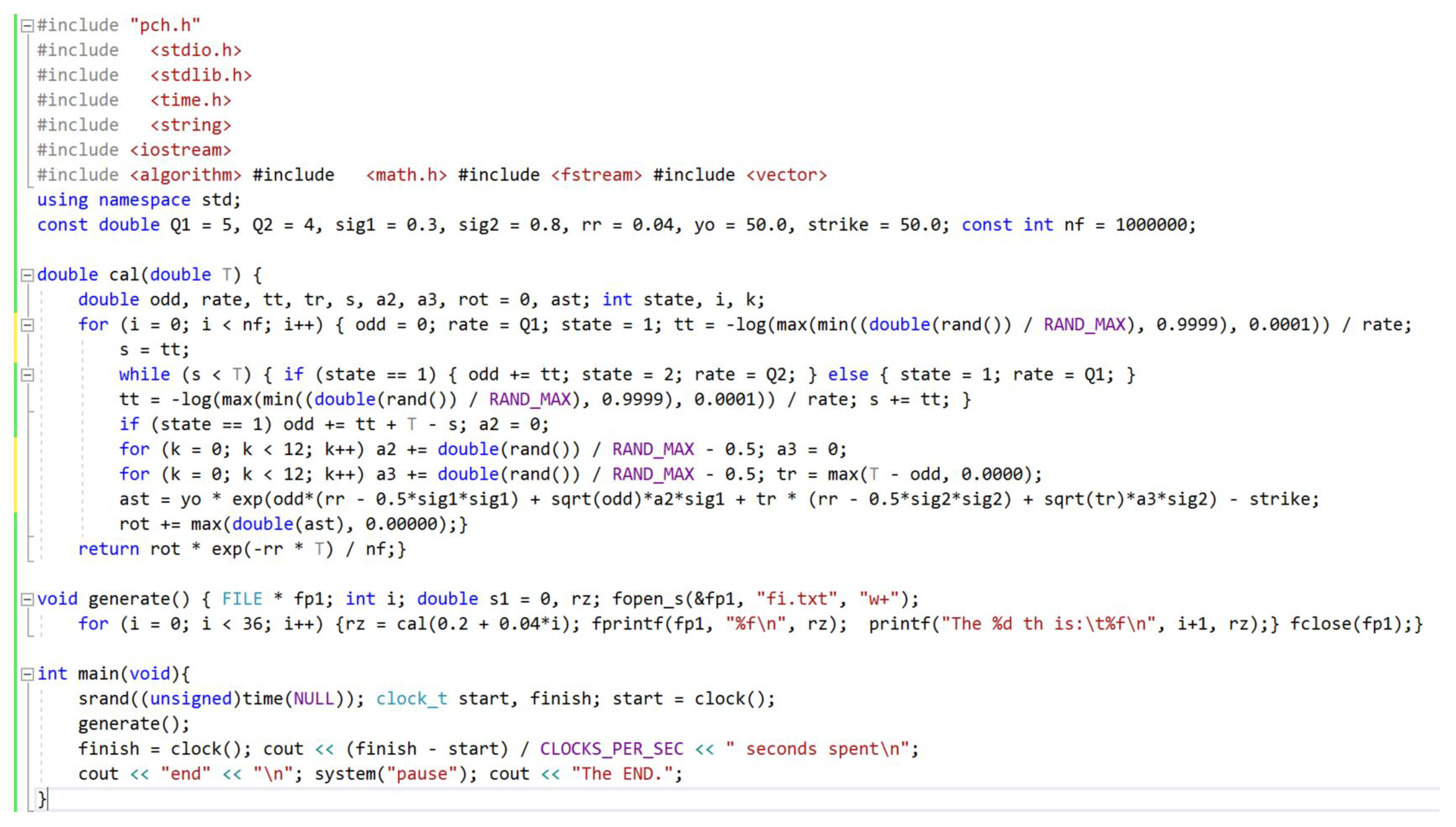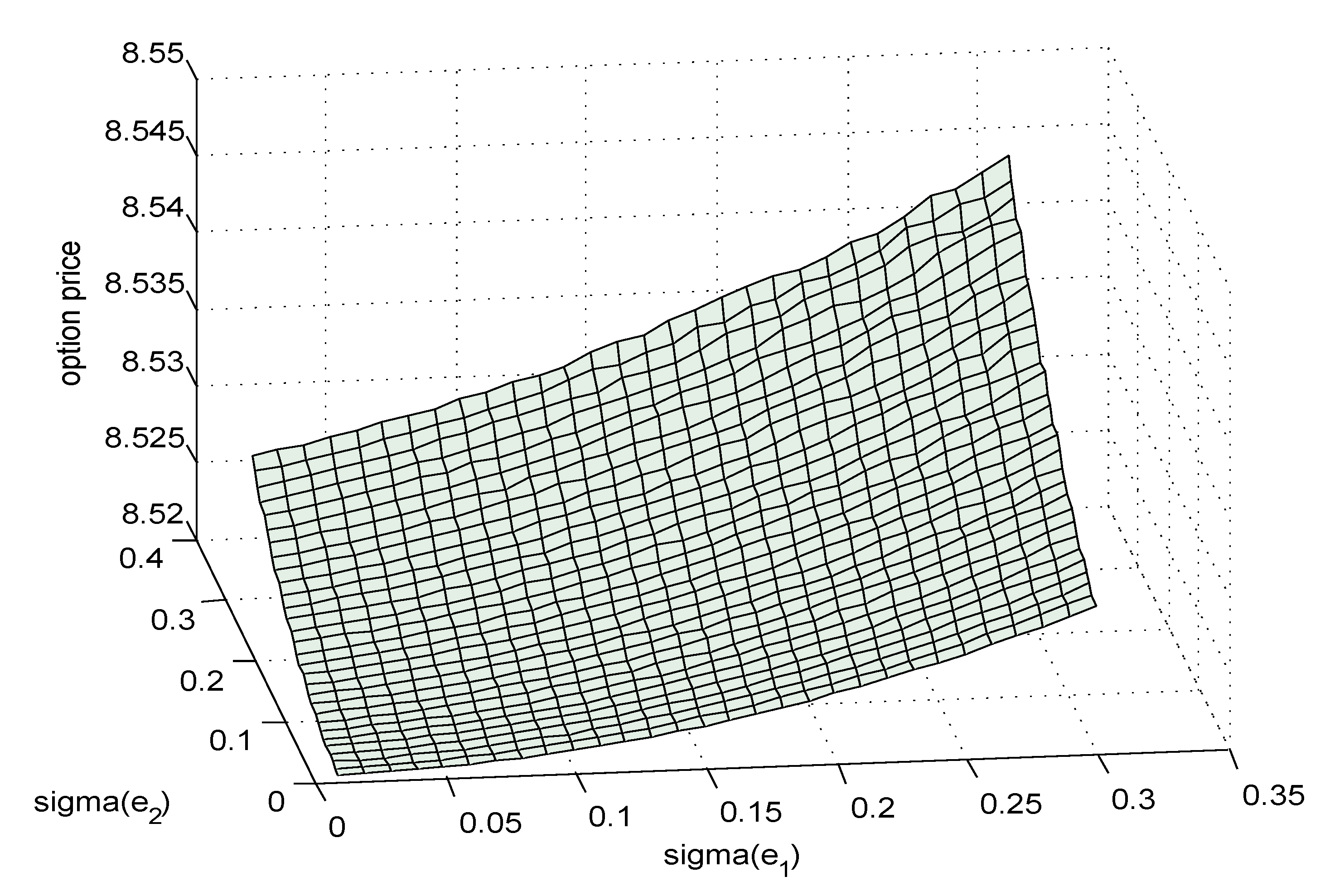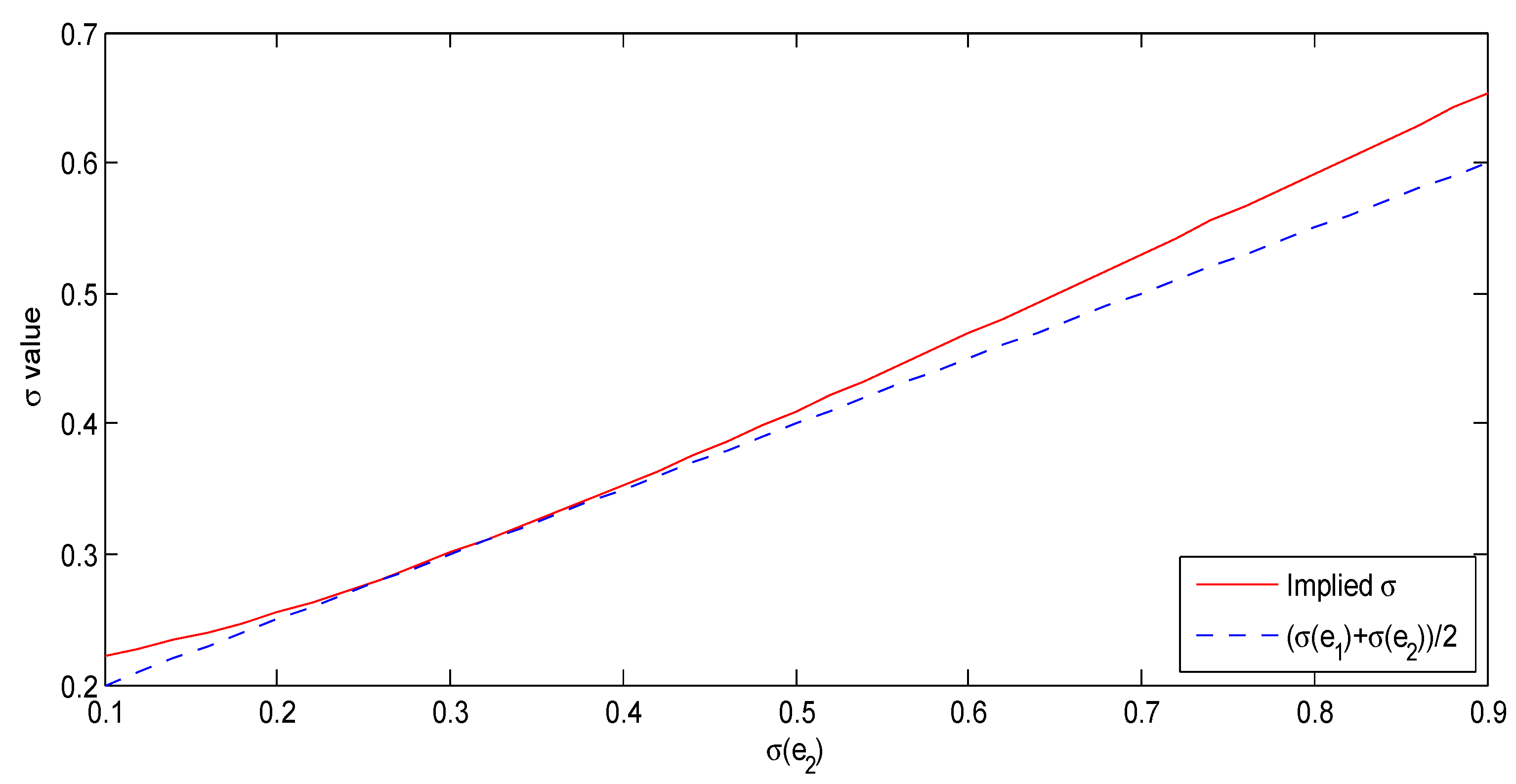Closed-Form Expression of Geometric Brownian Motion with Regime-Switching and Its Applications to European Option Pricing
Abstract
1. Introduction
2. Formulation
3. Calculation
3.1. Infinitesimal Generator
3.2. Moment-Generating Function
3.3. Expression of Value Function
4. Verification
4.1. A Special Case to Justify Our Formulas
4.2. Comparison with Other Methods
- Ref. [4] provides a recursive algorithm, which designs the recursion based on the jump times of a Markov chain. An alternative to this might be a backward recursive algorithm designed in [17], which applies a discretization of the time interval, where its value function and reward function are defined as and , respectively. The backward recursive algorithm is briefly shown by the pseudo-code (Algorithm 1) below.
Algorithm 1 Algorithm to compute the option value function V Require: Maturity date T, strike price K, drift factor , volatility , risk-free capital return rate r. Ensure: and for each and . 1: for all do 2: for all do 3: calculate ; 4: end for 5: end for 6: for each backwardly do 7: for all do 8: for each sample given do 9: if then 10: obtain a sample ; 11: else [] 12: obtain a sample ; 13: end if 14: average the samples of to obtain ; 15: end for 16: end for 17: end for - The traditional method to compute this expectation uses Monte Carlo simulation to obtain the mean value of samples. We attach the codes of this algorithm in the Appendix A, and indeed, the way of simulating the regime-switching model based on geometric Brownian motion is optimized and very efficient.
- The curve of implied volatility is in all ranges higher than the average of the volatility parameters. The reason for accounting for this phenomenon is that switching regimes will bring in some variance, and it will enlarge the volatility of the whole system.
- By increasing the value of another volatility parameter (namely ), the gap between the curve of implied volatility and the average volatility is also amplifying. The reason behind it is that a larger difference between states will cause larger influences on the variance of the model once regime-switching happens.
- Two curves join when , indeed, that is, . Because when parameters of different regimes are the same, there will exist virtually no regime-switching. Hence, the extra variance caused by regime-switching perishes, and the implied volatility equals the average value of volatility parameters.
5. Conclusions
Author Contributions
Funding
Institutional Review Board Statement
Informed Consent Statement
Data Availability Statement
Conflicts of Interest
Appendix A

References
- Hamilton, J.D. A new approach to the economic analysis of non-stationary time series. Econometrica 1989, 57, 357–384. [Google Scholar] [CrossRef]
- Liu, Y.; Tian, L.X.; Sun, H.P.; Zhang, X.L.; Kong, C.M. Option pricing of carbon asset and its application in digital decision-making of carbon asset. Appl. Energy 2022, 310, 118375. [Google Scholar] [CrossRef]
- Liu, Y.; Tian, L.X.; Xie, Z.Y.; Zhen, Z.L.; Sun, H.P. Option to survive or surrender: Carbon asset management and optimization in thermal power enterprises from China. J. Clean. Prod. 2021, 314, 128006. [Google Scholar] [CrossRef]
- Yao, D.D.; Zhang, Q.; Zhou, X.Y. A regime-switching model for European options. Int. Ser. Oper. Res. Manag. Sci. 2006, 94, 281–300. [Google Scholar]
- Liu, R.H.; Zhang, Q.; Yin, G. Option pricing in a regime-switching model using the fast Fourier transform. Int. J. Stoch. Anal. 2006, 12–19. [Google Scholar]
- Biswas, A.; Goswami, A.; Overbeck, L. Option pricing in a regime switching stochastic volatility model. Stat. Probab. Lett. 2018, 138, 116–126. [Google Scholar] [CrossRef]
- Ma, J.; Zhou, Z. Convergence Analysis of iterative Laplace transform methods for the coupled PDEs from regime-switching option pricing. J. Sci. Comput. 2018, 75, 1656–1674. [Google Scholar] [CrossRef]
- Tour, G.; Thakoor, N.; Khaliq, A.Q.M.; Tangman, D.Y. COS method for option pricing under a regime-switching model with time-changed Levy processes. Quant. Financ. 2018, 18, 673–692. [Google Scholar] [CrossRef]
- Yang, A.J.; Liu, Y.; Xiang, J.; Yang, H.Q. Optimal buying at the global minimum in a regime switching model. Math. Soc. Sci. 2016, 84, 50–55. [Google Scholar] [CrossRef]
- Darroch, J.N.; Morris, K.W. Passage-Time Generating Functions for Continuous-Time Finite Markov Chains. J. Appl. Prob. 1968, 5, 414–426. [Google Scholar] [CrossRef]
- Heidergott, B.; Leahu, H.; Löpker, A.; Pflug, G. Perturbation Analysis of Inhomogeneous Finite Markov Chains. Adv. Appl. Probab. 2016, 84, 255–273. [Google Scholar] [CrossRef]
- Pedler, P.J. Occupation times for two state markov chains. J. Appl. Prob. 1971, 8, 381–390. [Google Scholar] [CrossRef]
- Privault, N. Understanding Markov Chains—Examples and Applications; Springer Undergraduate Mathematics Series; Springer: Berlin/Heidelberg, Germany, 2013. [Google Scholar]
- Jagerman, D.L. An inversion technique for the Laplace trasform. Bell Labs Tech. J. 1982, 61, 669–710. [Google Scholar]
- Puri, P.; Kythe, P.K. Some inverse Laplace transforms of exponential form. Z. Angew. Math. Und Phys. Zamp 1988, 39, 150–156. [Google Scholar] [CrossRef]
- Sheng, H.; Li, Y.; Chen, Y.Q. Application of numerical inverse Laplace transform algorithms in fractional calculus. J. Frankl. Inst. 2011, 348, 315–330. [Google Scholar] [CrossRef]
- Liu, Y.; Nicolas, P. A recursive algorithm for selling at the ultimate maximum in regime-switching models. Methodol. Comput. Appl. Probab. 2018, 20, 369–384. [Google Scholar] [CrossRef]
- Hull, J.C. Options, Futures, and Other Derivatives, 4th ed.; Prentice Hall: Upper Saddle River, NJ, USA, 2000. [Google Scholar]





| K (Strike Price) | r (Return Rate) | T (Option Duration) | (of Q Matrix) | |
|---|---|---|---|---|
| 2.0 | 0.3 | 1.0 |
| Parameter: | y | T | K | r | |||||
|---|---|---|---|---|---|---|---|---|---|
| Value: | 50 | [0.2:1.6] | 50 | 0.04 | 0.3 | 0.8 | 5 | 4 | |
| Remark: | value range | at the money |
| Parameter | y | T | K | r | |||||
|---|---|---|---|---|---|---|---|---|---|
| Value: | 50 | 1.0 | [30:70] | 0.04 | [0.1:0.9] | 5 | 4 | ||
| Remark: | one year | value range |
Disclaimer/Publisher’s Note: The statements, opinions and data contained in all publications are solely those of the individual author(s) and contributor(s) and not of MDPI and/or the editor(s). MDPI and/or the editor(s) disclaim responsibility for any injury to people or property resulting from any ideas, methods, instructions or products referred to in the content. |
© 2023 by the authors. Licensee MDPI, Basel, Switzerland. This article is an open access article distributed under the terms and conditions of the Creative Commons Attribution (CC BY) license (https://creativecommons.org/licenses/by/4.0/).
Share and Cite
Fang, C.-Y.; Liu, Y.; Shi, Z.-Y.; Chen, C. Closed-Form Expression of Geometric Brownian Motion with Regime-Switching and Its Applications to European Option Pricing. Symmetry 2023, 15, 575. https://doi.org/10.3390/sym15030575
Fang C-Y, Liu Y, Shi Z-Y, Chen C. Closed-Form Expression of Geometric Brownian Motion with Regime-Switching and Its Applications to European Option Pricing. Symmetry. 2023; 15(3):575. https://doi.org/10.3390/sym15030575
Chicago/Turabian StyleFang, Cheng-Yu, Yue Liu, Zhi-Yan Shi, and Cong Chen. 2023. "Closed-Form Expression of Geometric Brownian Motion with Regime-Switching and Its Applications to European Option Pricing" Symmetry 15, no. 3: 575. https://doi.org/10.3390/sym15030575
APA StyleFang, C.-Y., Liu, Y., Shi, Z.-Y., & Chen, C. (2023). Closed-Form Expression of Geometric Brownian Motion with Regime-Switching and Its Applications to European Option Pricing. Symmetry, 15(3), 575. https://doi.org/10.3390/sym15030575







